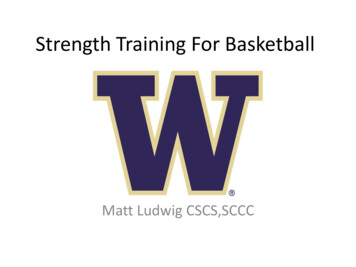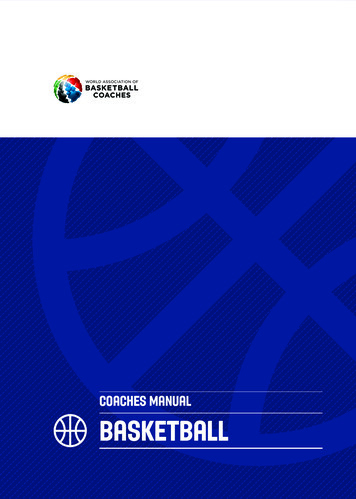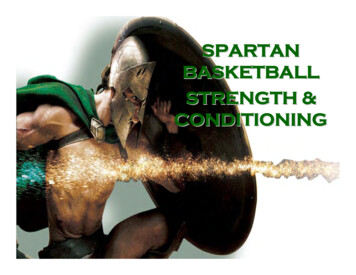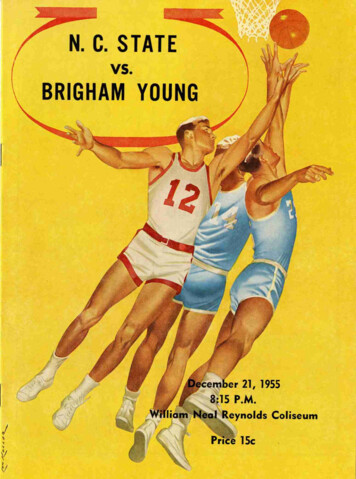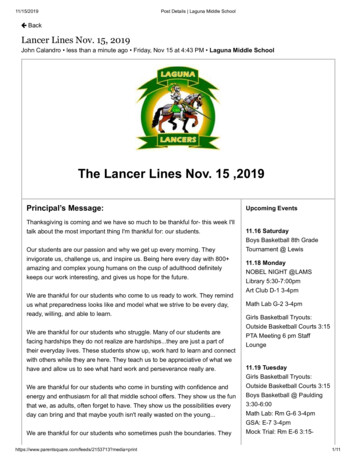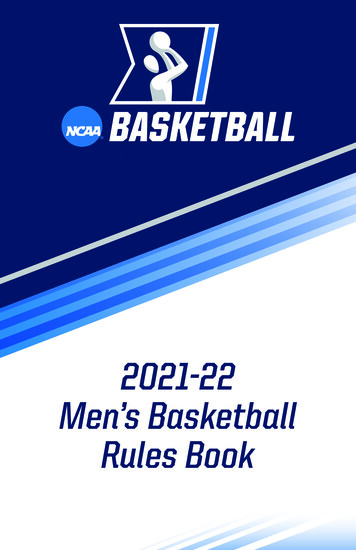
Transcription
2021-22Men’s BasketballRules Book
IFiLOSEI’LL RESPOND WITH RESPECT.Don’t undo my hard workwith poor sportsmanship.
2021-22 NCAAMEN’S BASKETBALLRULESNATIONAL COLLEGIATE ATHLETIC ASSOCIATION
[ISSN 1042-3877]THE NATIONAL COLLEGIATE ATHLETIC ASSOCIATIONP.O. BOX 6222INDIANAPOLIS, INDIANA 46206-6222317-917-6222NCAA.ORGAUGUST 2021Manuscript Prepared By: Art Hyland, Secretary-Rules Editor, NCAA Men’s Basketball RulesCommittee.Edited By: Andy Supergan, Assistant Director of Playing Rules and Officiating.NCAA, NCAA logo and NATIONAL COLLEGIATE ATHLETIC ASSOCIATION are registered marksof the Association and use in any manner is prohibited unless prior approval is obtained from theAssociation.COPYRIGHT, 1974, BY THE NATIONAL COLLEGIATE ATHLETIC ASSOCIATIONREPRINTED: 1975, 1976, 1977, 1978, 1979, 1980, 1981, 1982, 1983, 1984, 1985,1986, 1987, 1988, 1989, 1990, 1991, 1992, 1993, 1994, 1995, 1996, 1997, 1998, 1999,2000, 2001, 2002, 2003, 2004, 2005, 2006, 2007, 2008, 2009, 2010, 2011, 2012, 2013,2015, 2017, 2018, 2019, 2020, 2021PRINTED IN THE UNITED STATES OF AMERICA
ContentsNCAA Men’s Basketball Rules Committee 4Rules Changes for 2021-22 5Major Officiating Concerns 6Significant Editorial Changes 7PrefaceSportsmanship Statement 8Important Information for Manufacturers of New Equipmentand Apparel 9Court and Equipment 10Court Diagram 124- Foot Restricted-Area Arc 14Official NCAA Men’s Basketball RulesRULE 1 — Court and Equipment 15RULE 2 — Officials and Their Duties 30RULE 3 — Players and Substitutes 39RULE 4 — Definitions 43RULE 5 — Scoring and Timing Regulations 57RULE 6 — Live Ball and Dead Ball 68RULE 7 — Out of Bounds and the Throw-in 71RULE 8 — Free Throw 77RULE 9 — Violations and Penalties 81RULE 10 — Fouls and Penalties 90RULE 11 — Instant Replay 101AppendixesAppendix I — Fight-Reporting Procedures 106Appendix II — NCAA Tobacco Policy 107Appendix III — Officiating Guidelines 108Appendix IV — Foul/Penalty Chart 111Appendix V — Major Rules Differences 115Appendix VI — Timeout Comparison Chart 122Appendix VII — Concussions 125Appendix VIII — Accommodations for Student-Athleteswith Disabilities 127Appendix IX — Official Men’s Basketball Signals 128Index—NCAA Men’s Basketball Rules 1393
NCAA Men’s BasketballRules CommitteeThe chart below lists the members of the committee who voted on andapproved the rules included in this edition of the book. This information isbeing included for historical purposes.NameInstitutionTerm ExpirationRick BarnesUniversity of Tennessee,Knoxville9-1-23Jim BooneUniversity of Arkansas, FortSmith9-1-23Tad Boyle, ChairUniversity of Colorado,Boulder9-1-21Paul BrazeauAtlantic Coast Conference9-1-24Chris ClunieDavidson College9-1-23Terry DonovanCalifornia State University,Stanislaus9-1-23Rick HartzellUpper Iowa University9-1-24Bob HugginsWest Virginia University9-1-22Art Hyland*Secretary-Rules Editor9-1-22Robert LineburgRadford University9-1-21Mike McGrathUniversity of Chicago9-1-21Steve SchweerIllinois College9-1-23Gary StewartStevenson University9-1-23*Non-voting memberFor a complete and current listing of the NCAA Men’s Basketball RulesCommittee, please go to ncaa.org/playingrules.Those seeking interpretations or clarifications of the NCAA Men’s BasketballRules may contact: Art Hyland, NCAA Men’s Basketball Secretary-Rules EditorCell: 774-487-0640; Email: art.hyland@comcast.net4
Men’s Basketball RulesChanges for 2021-22Each changed or altered segment is identified in the rules text by a blue shadedbackground.Shot Clock - (Rule 1-19.2) Permits but does not require shot clocks to displaytenths of a second with under 5 seconds remaining.Undershirts - (Rule 1-23.1) Permits the wearing of compression shirts orlong-sleeved undershirts that extend below the elbows. One manufacturer’s logomeeting the restrictions of Rule 1-25.1 is permitted.Warning Horn - (Rule 2-10.9) Requires that a disqualified player be replacedbefore expiration of the 20-second warning horn.Resetting the Shot Clock - (Rules 2-11.6.b.9 and 7-4.1) Clarifies that theshot clock shall be reset to 20 seconds when one team causes the ball to be outof bounds on a jump ball and the other team is awarded possession in theirbackcourt.Double Technical/Simultaneous Technical - (Rule 10-1 Penalty h) Requiresfree throws to cancel when penalties are equal when committed during thestopped-clock period.Starting Lineup - (Rule 10-2.2.a Penalty 2.a) Permits enforcement ofviolations at any time before the end of the first period.Transmission of Live Stats to the Bench - (Rule 10-4.2.d) Permits transmissionof live stats to the bench area for coaching purposes.Instant Replay/Out of Bounds - (Rule 11-2.1.e.1) Permits use of replay todetermine which team caused the ball to be out of bounds, but only after a callhas been made.Instant Replay/Goaltending or Basket Interference - (Rule 11-2.1.e.3)Directs officials to place time back on the game clock following an InstantReplay review of a goaltending or basket interference call.5
Major Officiating ConcernsThe rules committee continues to express concern over the level of physicalplay in the game. In addition, the committee wants to ensure that there isadequate enforcement of all rules related to the freedom of movement. Tothis end, the committee has identified several areas of concern noted below:Handchecking/Body BumpingLast season these fouls were not enforced consistently during the early part of theseason. Enforcement of handchecking/body bumping early in the game sets thetone for reduced physicality in other parts of the game. These rules need to beenforced correctly throughout the entire season.Post PlayCall the first displacement either by the offense or the defense especially onbackdown plays. Players will adjust.ScreeningEnforce all screening rules including the legal width of the screen, a screenoutside the field of vision of a stationary opponent, and defensive playersillegally forcing their way through a screener.TravelingOfficiating should focus on traveling violations especially on the perimeter andin the post area. Failure to enforce the traveling rules creates a huge advantagefor a player who is permitted to violate.FloppingThe committee continues to express concerns that the flopping rule needs to beenforced consistently throughout the entire season. Faking being fouled needsto come out of the game.Pile-On SituationsEnforce dive-on fouls and correctly adjudicate jump ball/timeout situations.Bench DecorumEnforce the bench decorum, coaching box and other unsporting conduct rulesfairly and consistently.Call the Rules As Written!6
Significant EditorialChangesNote: These are additions/clarifications that have been part of interpretationsor custom but have not appeared in the rules book. Rule and Section referencesare for this edition unless otherwise indicated. There have been many minoreditorial changes to clean up language and eliminate wordiness.RULE 1 — Court and Equipment1-12.1Clarified1-25.2ClarifiedRULE 2 — Officials and Their 2ClarifiedRULE 5 — Scoring and Timing5-3.2.5.aRewritten and ClarifiedRULE 7 — Out of Bounds and the arified7-4.17Rewritten and Clarified8-2.2Rewritten and ClarifiedRULE 8 — Free Throw8-2.1Clarified8-5.1.fClarifiedRULE 9 — Violations and Penalties9-1.1.fClarifiedRULE 10 — Fouls and Penalties10-1.5.dRewritten and Clarified7
PrefaceSportsmanship StatementThe primary goal of the rules is to maximize the safety and enjoyment of thestudent-athlete. Sportsmanship is a key part of that goal. Sportsmanship shouldbe a core value in behavior of players and bench personnel, in crowd controlby game management and in the officials’ proper enforcement of the rulesgoverning related actions.The NCAA Men’s Basketball Rules have been designated as eitheradministrative rules or conduct rules. Typically, administrative rules are thosedealing with preparation for the contest. The conduct rules are those that dealdirectly with the playing of the contest. Some administrative rules (as indicated)may be altered by mutual consent of the competing institutions. Others (asindicated) are unalterable. No conduct rule may be changed by mutual consent.All NCAA member institutions are required to conduct their intercollegiatecontests according to these rules.In the Men’s Basketball Rules, the administrative rules that may be altered bymutual consent of the competing institutions are Rule 1, Sections 2, 3 and 20.The administrative rules that may not be altered are Rule 1, Sections 4 through8, 15, 16 and 18; Rule 2, Section 1; and the free-throw lane diagram. All ofthe other rules are conduct rules and may not be altered.The rules are divided into articles for ease of reference. Equipment/apparel rules that are of concern primarily to manufacturers are contained inthe front of this section. All court measurements are included on the expandedcourt diagram.Those desiring interpretations of rules or play situations are asked to sendquestions via email.Art Hyland, Men’s Secretary-Rules Editor; art.hyland@comcast.net.Note: Officials may find updates and interpretations at:ncaambb.arbitersports.com8
Important Informationfor Manufacturers of NewEquipment and ApparelThe NCAA Men’s Basketball Rules Committee is responsible for formulatingthe official playing rules for the sport. The committee is not responsiblefor testing or approving playing equipment for use in intercollegiate men’sbasketball.Equipment manufacturers have undertaken the responsibility for thedevelopment of playing equipment that meets the s pecifications establishedfrom time to time by the committee. The NCAA urges manufacturers towork with the various independent testing agencies to maximize the safety ofproducts. Neither the NCAA nor the NCAA Men’s Basketball Rules Committeecertifies the safety of any basketball equipment. Only equipment that meetsthe dimensions specified in the NCAA Men’s Basketball Rules shall be usedin intercollegiate competition. Similarly, only uniforms that meet the rulesspecifications shall be used.While the committee does not regulate the development of new equipmentand does not set technical or scientific standards for testing equipment or theapproval or disapproval of specific playing equipment, the committee may,from time to time, provide manufacturers with informal guidelines as to theequipment-performance levels it considers consistent with the integrity of thegame. The committee reserves the right to intercede in order to protect andmaintain that integrity.In general, the rules addressing uniforms are intended to positively impactthe following needs:COACHING - Identification of an opponent’s personnel when scouting onvideo and for in-game coaching strategy.OFFICIATING - Proper foul reporting, identification of disqualified playeror players involved in an altercation.IMAGE - How players appear on television/fan appeal.The NCAA Men’s Basketball Rules Committee suggests that manufacturersplanning innovative changes in basketball equipment submit the equipment tothe NCAA Men’s Basketball Rules Committee for review before production.9
Court and Equipment1. Playing Area. When possible, building plans should provide for a playingcourt with ideal measurements as stated in Rule 1-2 and listed on the courtdiagram, ample out-of-bounds area and needed seating space for scorers,timers and fans. A long playing court permits use of two crosswise courts forpractice and informal games.It is recommended that padding that meets current ASTM standards beused on walls and other facility features in or around the playing area thata student-athlete might contact during play. Padding should be installed nomore than 4 inches from the floor up to 6 feet.2. Ceiling. The ceiling and anything hanging from it (other than the basket)should be at least 25 feet above the playing court and higher if possible.3. Boundaries. The committee recommends that a belt 8 inches or more inwidth be used to mark the boundaries on all courts that have at least 10 feetof open space between the boundary lines and the seating. This plan is urgedfor all new construction and for other similar courts when the boundaries arere-marked.4. Lighting. The court should be uniformly and adequately lighted. Lightingengineers should be placed in charge of this important factor when planningany new installations. For information on recommended specifications forlighting, contact the Illuminating Engineering Society of North America,120 Wall Street, 17th Floor, New York, New York 10005; telephone 212248-5000.5. Warning on misuse of portable backstops. Manufacturers andadministrators should be aware of an “extreme-caution” warning relativeto the misuse of portable backstops. A high degree of injury potential anda severe liability problem exist when anyone is allowed to hang, sit or standon the basket ring or backboard. Administrators must see that this practiceis prohibited or that the portable units are lowered at the completion of thegame because of the high risk of severe injury, even death. A recommendedwarning or inscription such as “Danger—please do not get on the rim/backboard” is desirable.6. Locking Backboard. It is recommended that a locking device/safetyarrester be used for ceiling and wall-mount backboard systems that areretracted by motor-pulley cable arrangements.7. Backboard Padding. It is recommended that the required padding forthe backboard be mounted on the backboard by adhesive or material suchas Velcro or channel. The bottom and each side of the backboards shall bepadded with a Poly High-Car vinyl-type material that meets the Bashorresilience test with a range of 20-30.A lavaliere-type microphone properly positioned in the crease of thebackboard padding or between padding and backboard is permitted since it10
Court and Equipment 11is not located on the padding and does not interfere with a live ball or createa safety hazard.8. Ring. The design of the ring and its construction should be such asto maximize player safety. A movable basket ring shall have reboundcharacteristics identical to those of a nonmovable ring. The pressure-releasemechanism should maximize these characteristics, as well as protect both thering and backboard. Movable rings are required.9. Ring Testing. It is required for Division I and recommended for DivisionsII and III that all competitive rings for men be tested for rebound/elasticityonce before the season and once before the postseason. It is recommendedfurther, in all divisions, that basket ring loads be transferred to the supportsystem by a single strut boom behind the backboard, or to the backboardframe. The pressure-release/elasticity mechanism on movable rings maybe field adjustable. When released, the ring shall not rotate more than 30degrees below the original horizontal position. After release and with the loadno longer applied, the ring shall return automatically and instantaneously toits original position.10. Marking the Court. When marking a court, manufacturers should start atthe center of the court rather than at either end.11. Timing Equipment. Divisions I, II and III schools shall have a game clockthat shows a 10th-of-a-second display when less than one minute remains ina period.Divisions I, II and III schools shall have either a red light placed behindeach backboard that is visible through the 24-inch-by-18-inch rectangleor LED lights around the backboard. The purpose of either is to indicatewhen player activity is terminated. If LED lights are used, they shall bepositioned not more than 6 inches from the upper and lower edges of thebackboard and not more than 5 inches from the side of each backboard.When both lights are present, the LED lights shall take precedence, and thered light shall be disconnected. It is recommended that the game clock, redlight or LED lights be updated in their synchronization.It is recommended that all men’s Division I arenas provide a timingmechanism that enables the officials to start and stop the game clockautomatically. It is permissible also to have LED lights at the scorers' tablewhich are synchronized with the red lights/LED lights on the backboardsand game clocks.A pole attached to the shot clock that is used to mount a camera or acamera attached to the shot clock is permissible when the shot clock isrecessed behind the backboard and does not interfere with a live ball, nordoes it affect the visibility of the shot clock.
(June 24, 2021)12 Court Diagram
Court Diagram 13
14 4-Foot Restricted-Area ArcNCAA BasketballRestricted-Area ArcIBASELINE163" ---- - - -6'--- - - ----i15"48"(to inner edge)2"The width of thisline shall be 2"RESTRICTEDAREA48" RADIUS48" from center of ringto inner edge of lineINSTRUCTIONS1. To place the arc on the floor, mark a spot on the floor directly under the centerof the basket.2. Using a measuring device, create a semicircle that extends four feet.(Note: No. 4 below provides detail for measuring these distances.)3. Measure several points from the center of the basket, including two pointsalong a plane parallel to the backboard.4. The restricted area arc shall be drawn as a two-inch line with thE inner edgeof the line measuring four feet from the center of the basket.5. At the diameter points of the semicircle (the plane parallel to the backboard),the line straightens, similar to the three-point line.6. The arc's straight lines shall end at the front edge of the backboard.
RULE 1Court and EquipmentSection 1. The GameArt. 1. Basketball is played by two teams of five players each. The objective isfor each team to score points by throwing or tapping the ball into its own basketand to prevent the other team from scoring.Art. 2. A team’s own basket is the one into which its players try to throw or tapthe ball. Each team shall warm up and shoot during the first half at the basketfarthest from its bench.Art. 3. The teams shall change baskets for the second half.Art. 4. The ball may be thrown, batted, rolled or dribbled in any direction,subject to the restrictions in these rules.Section 2. The Playing Court—DimensionsArt. 1. The playing court is the area on the floor that lies within the geometricallines formed by the inside edge of the boundary lines.Art. 2. The playing court shall be a rectangular surface free from obstructionswith sidelines of 94 feet in length and end lines of 50 feet in length, measuredfrom the inside edges of these lines.Art. 3. The court dimensions and other mandatory markings are shown on theCourt Diagram.Section 3. Boundary Lines, Restraining Lines and Other MarkingsArt. 1. The court shall be marked with boundary lines (sidelines and endlines), restraining lines and other mandatory lines and markings as shown onthe Court Diagram. All lines must be clearly discernible and distinguishable.Art. 2. Instead of the 2-inch boundaries listed on the Court Diagram, it islegal to use contrasting-colored floor areas by painting the out-of-bounds area,the center circle, and the free-throw lanes and lines so that the mathematicalline between the two colors is the boundary. Such a contrasting-colored out-ofbounds belt should be at least 8 inches wide.Art. 3. The restraining line shall be a solid, interrupted or mathematical lineformed between two colors. The line may be a color that is either the same ordifferent from that of the end lines. When space is not available for a 6-footrestraining line, the line should be marked using the maximum availabledistance. Non-playing personnel shall not be permitted in this area when theball is live.Art. 4. A shadow line is a line that designates the required 2-inch width by use ofborder lines at least 1/4-inch wide, all of which shall lie within the 2-inch width.All shadow lines must be clearly discernible and distinguishable.15
16 RULE 1 / Court and EquipmentArt. 5. When the floor has a logo on the playing court, that logo should notdistract from the players’ and the officials’ visibility of the division line or centercircle line.Art. 6. One of the following shall be placed on the floor at the division line infront of the official scorers’ table:a. An “X” composed of 12-inch line segments that are 2 inches in width.b. An NCAA logo that is a minimum of approximately 8 inches in diameter.c. An NCAA Basketball logo that is located in a rectangle that isapproximately 1½ feet by 2½ feet.Section 4. Center CircleArt. 1. When a logo is placed on the playing court and it partially orcompletely obscures the 2-inch center-circle line as shown on the court diagram,the following shall be permissible:a. A solid 2-inch-wide interrupted line: 4 inches long, 2-inch break, 4 incheslong, 2-inch break, etc.b. A shadow-bordered 2-inch-wide line (1/4-inch borders).c. A 2-inch wide interrupted shadow line: 4 inches, 2-inch break, 4 inches,2-inch break, etc.d. A 1/4-inch, single-bordered line (radius of 6 feet to the outside edge).e. A mathematical line formed by contrasting-colored floor areas.Art. 2. The unmarked spaces for the non-jumpers around the center circle shallbe 36 inches deep.Section 5. Division LineArt. 1. A 2-inch-wide division line shall divide the playing court into twoequal parts and shall be formed by extending the center-circle diameter in bothdirections until it intersects the sidelines.Art. 2. Instead of the solid 2-inch line as shown on the court diagram, thefollowing shall be permissible:a. A solid 2-inch-wide interrupted line: 4 inches, 2-inch break, 4 inches,2-inch break, etc.b. A shadow-bordered 2-inch-wide line (1/4-inch borders).c. An interrupted 2-inch-wide shadow line: 4 inches, 2-inch break, 4 inches,2-inch break, etc.Section 6. Free-Throw LaneArt. 1. All lines designating the free-throw lane, except lane-space marks andblocks, are part of the lane.Art. 2. The color of the lane-space marks and blocks may contrast or be of thesame color as the lane boundary lines.Art. 3. It is highly recommended that the area of the free-throw lane inside theboundary lines be one color. It is permissible for this area to be more than onecolor as long as all required lines in and around the lane are clearly discernibleand distinguishable.
RULE 1 / Court and Equipment 17Art. 4. The lane-space marks and blocks shall identify the lane space areas thatextend 36 inches from the outer edge of the lane lines toward the sidelines.Section 7. Three-Point Field-Goal LineArt. 1. The three-point field-goal line shall be a distance of 22 feet, 13/4 inches fromthe center of the basket to the outside edge of the three-point field-goal line and 21feet, 77/8 inches in the corners. See Court Diagrams on Pages 12 and 13.Art. 2. The three-point field-goal line shall be a solid single-colored 2-inch line.The lines may be the same color as or a different color from the free-throw laneboundary lines and the semicircles. When more than one three-point line existson the playing court, the lines shall contrast in color and there shall be no formof embellishment or belt between the lines.Section 8. Restricted-Area ArcThe restricted-area arc is a solid single-colored 2-inch line formed by a semicirclemeasured from the center of the basket to the inside edge with a radius of 4feet and extending in a straight line to the front face of the backboard. This arcmust be clearly discernible and distinguishable. When there are both a 3-footand 4-foot arc on the playing court, the arcs shall contrast in color. Note: Seeillustration on Page 14 for details regarding 4-foot arcs. It is recommended that the3-foot arc be removed the next time the court is refinished.Section 9. Coaching BoxArt. 1. The coaching boxes shall extend from the sideline to the back of theteam benches and shall be bounded by the end line and no farther than the38-foot line as noted in the Court Diagram.Art. 2. A line perpendicular to the sideline with a minimum length of 2 feetshall be extended from the sideline, toward the team bench so that the coachingbox boundary is evident.Section 10. Backboards—Dimensions, MaterialsArt. 1. Each backboard shall be marked as depicted on the backboard diagram(See Page 18).Art. 2. The size of the backboards may be either of two dimensions:a. 6 feet horizontal and 3½ feet vertical; orb. 6 feet horizontal and 4 feet vertical.Note: The dimensions of 6 feet horizontal and 3½ feet vertical are recommended forreplacement backboards or new installations.Art. 3. The backboards shall be similar in size at both ends of the playing court.Art. 4. A transparent, unaltered, rigid, rectangular backboard with a flat surfaceshall be used.Art. 5. Backboards shall not be tinted.Section 11. Backboards—PaddingArt. 1. Padding is required on all backboards as outlined in this rule. The paddingshall be a single solid color and shall be the same color on both backboards.a. When it becomes necessary to use a substitute backboard, the paddingshall be of the same color as that of the backboard being replaced.
18 RULE 1 / Court and EquipmentArt. 2. The padding shall be 1-inch thick from the front and back surfaces ofthe backboards.Art. 3. The padding shall extend 2 inches from the bottom edge of each backboard.Art. 4. The padding shall cover the bottom surface of each backboardand the side surface to a distance of 15 inches up from the bottom.The front and back surface must be covered to a minimum distance of ¾inch from the bottom of each backboard.Institutional/conference social media decalsallowed on top edge of backboard frame.See Rule 1-17.1.5” x 8”flag/logo5” x 8”flag/logoconference or NCAA logo not to exceed 5” x 8” allowedin each corner. See Rule 1-17.1.Section 12. Backboards—Support SystemsArt. 1. Padding—Any backboard support behind a backboard and at a heightof less than 9 feet above the floor shall be padded on the bottom surface to adistance of 2 feet from the face of the backboard. All portable backstops shall
RULE 1 / Court and Equipment 19have the bases padded to a height of 7 feet on the courtside surface with no hardor potentially dangerous objects attached to it.Art. 2. Protrusions and Clearancesa. Protrusions below backboards shall not be allowed.b. Any backboard support, all of which is not directly behind the backboard,shall be at least 6 inches behind the backboard when the support extendsabove the top and at least 2 feet behind the backboard when the supportextends beyond the side.c. Any support system below or behind a backboard shall be at least 8 feetbehind the plane of the backboard face (and at least 4 feet from the endline) and a height of 7 feet or more above the floor.d. Any overhead backboard support structure that must be forward-bracedbecause of space limitations, architectural or structural restraints, shallmeet the following requirements: A front diagonal brace support systemmust be located above a line extending upward and into the playing courtat a maximum 45-degree angle from a point on a vertical line locateda minimum of 6 inches behind the front surface of the backboard at aminimum height of 4 feet 6 inches above the basket ring.Section 13. Backboards—PositionsArt. 1. Each backboard shall be positioned midway between each sideline, withthe plane of its front face perpendicular to the floor, parallel to and 4 feet fromeach end line.Art. 2. The upper edge of each backboard shall be 13 feet above the floor.Art. 3. Each backboard shall be protected from spectators to a distance of atleast 3 feet from the end of each backboard.Art. 4. Portable backboards shall be secured to the floor to prevent movement.Where arena configurations permit, it is recommended that a 3-foot wide escapelane on both sides of the basket stanchion be provided. Each escape lane shallextend at least to the restraining lane or the back edge of the basket stanchion,whichever is farthest from the end line.Art. 5. Neon, electric, LED or artificially lit signage shall be permitted on thehorizontal stanchion booms; however, it shall not be permitted on the verticalbackboard stanchion arms. The permitted signage
5 Men’s Basketball Rules Changes for 2021-22 Each changed or altered segment is identified in the rules text by a blue shaded background. Shot Clock - (Rule 1-19.2) Permits but does not require shot clocks to
